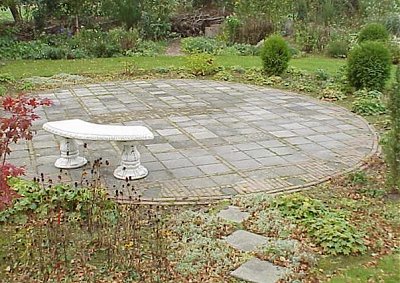
Analemmatic dials
Our former garden, Peize
In 1996 we moved from a house that had grown too large but with a small garden, to a small house with quite a large garden. Looking for a way to create large spaces, low in maintenance, we adopted the plan to lie out a terrace with an embedded analemmatic sundial.

|
The sundial terrace, seen in WNW direction. |
The analemmatic sundial appeals to me for two reasons. Firstly, it does not require an impractical, oblique pole to serve as a gnomon, which would always be in the way and needs quite some maintenance. And secondly, action is required to find out the time. This makes the dial an interactive device, turning the ancient instrument into a worthy part of our (computer) age.
The terrace thus should be an ellipse. We chose a major axis of 7.00 meters (23 feet). Peize is at 53°8' latitude, and as the sine of this angle is exactly 0.8, the minor axis had to be 5.60 meter. The calculations were performed in a spreadsheet, following the directions of Waugh.
The next step was to plot the major axis exactly in east-west direction. Fortunately, a power line pylon is visible from our garden in winter. As these pylons are indicated on the 1:25000 topographic map, I could find its direction: 34° south from east. I transferred this angle onto a sheet of paper and used this to lay out the major axis of the terrace.
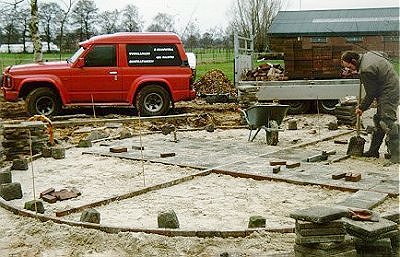 Egbert Klopstra, a gardener from Leutingewolde, then laid the terrace, making block patterns from 30x30 cm paving stones, lined with red bricks.
Egbert Klopstra, a gardener from Leutingewolde, then laid the terrace, making block patterns from 30x30 cm paving stones, lined with red bricks.
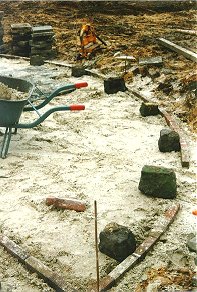 Cobblestones, originating from the former driveway, were used for the hour points. We chose to have the scale read daylight saving time. The 12 o'clock point was marked by a pair of lighter stones, and the 6, 9, 15, 18 en 21 o'clock points by a somewhat larger stone.
Cobblestones, originating from the former driveway, were used for the hour points. We chose to have the scale read daylight saving time. The 12 o'clock point was marked by a pair of lighter stones, and the 6, 9, 15, 18 en 21 o'clock points by a somewhat larger stone.
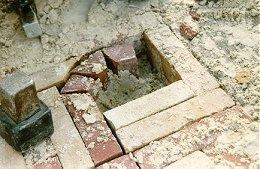 The date line is on the minor axis of the ellipse, oriented north-south. It had to be 1.82 meter long, which fitted in well with the block pattern. One row of paving stones was removed at both sides of the minor axis. The date scale was also made in brick, to keep in style with the rest of the terrace.
The date line is on the minor axis of the ellipse, oriented north-south. It had to be 1.82 meter long, which fitted in well with the block pattern. One row of paving stones was removed at both sides of the minor axis. The date scale was also made in brick, to keep in style with the rest of the terrace.
It seems impossible to lay out a readable scale using bricks, but Egbert did a terrific job, with the aid of his stone cutter. The initials of the months are shaped with red and yellow bricks.
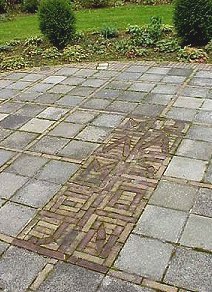 |
The date line. January through May is to the left (west), July through November to the right. June and December, which occupy only a few centimeters along the date line, were omitted. The light pair of stones in the back marks the 12 o'clock point. |
Temperatures dropped below zero during the paving work (it was shortly before Christmas '97), so the sand froze solid all the time. Egbert did not give up, however. And it should be said, the terrace still looks pretty smooth! The only thing we missed due to the severe weather was to indicate the foci of the ellipse. So that's still on our list...
 |
In early spring, each hour point is being accentuated by a bunch of daffodils, demonstrating the approval of the whole by the Chief gardener. |
Here's how the sundial is used:
Position yourself on the date line, on the spot indicated by the calendar alongside. The time is read where your shadow (or its extension) intersects with the perimeter of the ellipse. In the morning, count back to the left from the 12 o'clock mark; in the afternoon, continue counting to the right. If your shadow is too short in summer, you may extend it by pressing your hands together over your head.
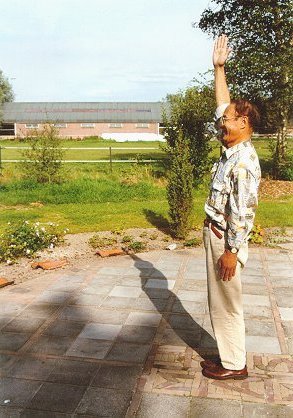 The sundial is functioning well in practice. I don't wear my watch when working in the garden, and I actually use the sundial to see if it's tea-time already.
The sundial is functioning well in practice. I don't wear my watch when working in the garden, and I actually use the sundial to see if it's tea-time already.
Here my colleague Takashi Hasegawa from Japan acts as a gnomon (August 16, around 5 pm).
The accuracy is some 5 - 10 minutes. Of course one should take the equation of time into account. A plaque with a graph or table would complete the sundial, but that has to be materialized yet...
Location: 53.1° N, 6.5° E
Design: Frans Maes, Peize
Construction: Egbert Klopstra, Leutingewolde
Inauguration: December 1997